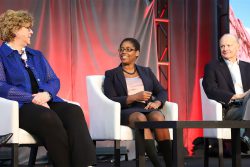Leading With the Head, the Heart and the Spine
This post was contributed by Yves Salomon-Fernández, president of Greenfield Community College and adjunct faculty member at the University of Massachusetts, Amherst.

Pictured (left to right): Panelists Elizabeth Davis, Yves Salomon-Fernández, and Steve Wrigley.
At the CUPA-HR Annual Conference in October, I had the privilege of serving on a panel with two other chief executives — the president of a private liberal arts university and a state system chancellor. We were invited to share some of the top challenges we face such as the changing student population, the cost to provide meaningful education and public confidence in higher education.
During the Q&A that followed our session, a member of the audience asked my co-panelists and me about the qualities that we look for when we bring on new talent or promote from within. As presidents, we each acknowledged that hiring is one of the most important parts of the job. For my part, I shared that I look for people who can lead with the head, the heart and the spine. As a sector, higher education faces the need for transformative change. Across our institutions and across the academy, we need people who are not afraid to lead, are not afraid of change, and embrace learning within and outside of their disciplines and functions. And most especially, people who are not afraid to model the skills and the behaviors that our students will need in order to flourish.
Leading From Any Position
The responsibility to steward and evolve our institutions falls upon each one of us, not just those with president and director in their titles. This past summer one of my faculty colleagues recommended that I read the book Co-Active Leadership, by Karen and Henry Kimsey-House, after I recommended Stewardship, by Peter Block, to her. Both books embrace the concept of leadership as stewardship and conceive of leadership not as a title but as service to one’s institution and for the greater good. Colleagues who read the Kimsey-House text embraced the authors’ conception of “leader within, leader up front, leader behind, leader beside, and leader in the field.”
We see evidence of this in campus leaders who have traditionally led from behind stepping up to lead committees on major initiatives like strategic planning. We have also seen it in front-line staff and middle managers making tough decisions as they evolve our governance committees. Additionally, we are seeing more leaders with titles that put them higher on the hierarchy stepping back to empower their teams to make the decisions the college needs because they are the subject matter experts.
Because Greenfield Community College is a rural college, the spirit of collaboration and doing whatever it takes to ensure the institution’s and the students’ success has always been part of our college ethic. However, the changing times call for all of us in higher education to be even more explicit about the varied positions from which we lead. Each of us has a responsibility to use our unique skills and abilities to stretch into the unknown and take risks. It begins with being curious, seeking out others and asking questions, and leading toward a dynamic solution — because we know it’s the right thing to do.
Having the Courage to Lead
We all need the courage to lead. For example, we need leaders who never get tired of trying and never give up. We need leaders to not only lead but also encourage others to see they possess the ability to lead. We need faculty and staff whose collective impact can lead us toward a more just and equitable world. And we need a higher education sector that can unleash the potential in each of our students and in each of us to contribute to the next scientific and medical discoveries, advance the humanities, release our human creativity, and ethically and responsibly steward our human and environmental resources.
In what ways can we begin to see a change? Some solutions are having:
- front-line staff fearlessly bringing unique perspectives to those focused on the 30,000-foot view;
- faculty using culturally relevant pedagogies that make all students feel seen and heard, and who help elevate the voices of groups that have traditionally been marginalized;
- faculty and staff serving as role models for our students, who are leading with conviction and purpose, and who are not afraid to take risks and fail; and
- those of us with the titles supporting and fostering the conditions for our colleagues and ourselves to lead with courage.
How will you and others lead with the head, heart and spine?
CUPA-HR Related Resources:
CUPA-HR Essentials Video: Developing Leadership Competencies in Higher Ed
What Makes a Successful Leader in a Changing Higher Ed Landscape?
Developing the Skill Set and Mindset of Future University Leaders


